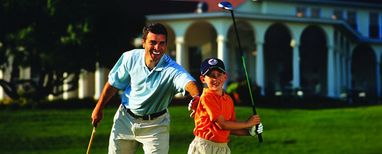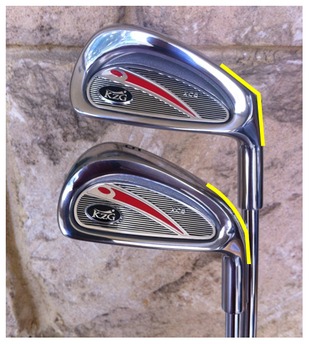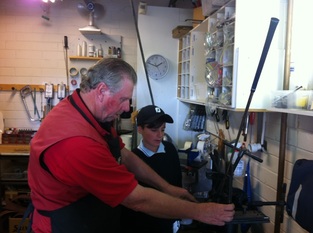 In recent times (over the last 15 years) there has been a huge leap forward in equipment that is available for junior golfers taking up the game at the entry level, and it's getting better. From clubs, bags, pull trolleys, shoes, gloves, caps and attire identical to the leading young "superstars" the junior golfer can "look the part". There are also the choice of right or left handed clubs, and more importantly, the weight, lie angle, grip size and length are suitable for juniors from five years old to around 11 years old. I believe that this better fitted equipment has been one of the main contributors to why there are so many more young golfers that are able to compete at a very high level sooner. It wasn't too long ago when a youngster taking up the game was confronted with the popular option of cutting down Dad's or Mum's old set of clubs to start off! The shafts by cutting and shortening them would effectively make them stiffer.  The lie angle (the way the club head sits on the ground at address and impact) would be too upright (toe up off the ground) for the junior, and combined with the stiffer shafts would encourage two things. First, the stiff shafts would help produce a low dipping ball flight causing the junior to hang back onto their right side (right handed) to try and help the ball to fly higher. Secondly, the upright lie angle will encourage a pull and/or hook even when the junior makes a good swing! Plus the heel of the club will contact the ground first and twist the club-face closed. An example in the picture opposite of two clubs that were identical until our master club-fitter / club maker Greg Ashton put the bottom club on a grinder and cambered the heel down. This has allowed two things to happen that will definitely suit a junior golfer. It will make the club lie angle easier to adjust, and more importantly it will take 20 grams of weight off, which makes the golf club a lot more suitable. The only way the junior can make the ball go straighter (when the shaft is too stiff and lie angle is too upright) is to grip the club with their hands turned to the right (right handed) until the right hand is positioned nearly under the grip, and the left hand is showing all the knuckles, which is considered a "strong grip," to try and stop the club face from closing. You're now getting the picture that these two conditions in a very short span of time can sabotage good dynamic balance, and encourage a weak blocking action. And once these two patterns have been grooved they are extremely difficult to change.  Master club-fitter / builder Greg Ashton working on a junior club Master club-fitter / builder Greg Ashton working on a junior club As I mentioned at the start, entry level equipment is better but there is a "gap" when the junior reaches around the age of 10 to 11 years of age. This is the age that girls in particular start to go through a growth spurt but are still not ready for adult clubs. In the recent 2013 US Women's Amateur ten year old Lucy Li competed and shot a 70 in the 2nd round. I can assure you she was not using junior or adult clubs. This is where a specialist club fitter/club maker is needed to build individually fitted clubs/sets that will encourage the junior to keep improving performance, leading to lower scores. When juniors at this stage start to increase their club head speed the entry level shafts are not suitable anymore. Mainly because they are too whippy, unstable and cause inconsistent contact and direction. The club fitter can identify the right length, weight and shaft frequency to suit the junior golfer and most importantly check the clubs at set intervals to make sure that they stay that way. If you are serious about your child's ongoing development through this cycle and beyond, you need to find a club fitter/club maker that you and your child can build a relationship with. Ask the professional that coaches your child for his/her recommendation, or even parents of other juniors that may use someone that they can refer you on to. All major manufacturers have junior golf sets in their range, but what I am saying is at some point your child will need to be individually fitted by a specialist who can build a set of golf clubs that will allow your child to achieve their full potential. In my view off the shelf clubs are great for juniors starting off, but from the age of eleven on-wards align yourself with a professional and/or clubfitter that will advise and guide you towards equipment that will enhance the ongoing development of your child. At Pro Tour Golf College we have master club fitter Greg Ashton to look after all our students equipment needs as we know that this is an essential part of the development pathway for all of our students. David Milne and Lawrie Montague - Pro Tour Golf College Your Success On Tour is Our Business Comments are closed.
|
Archives
June 2019
|
Proudly Supported By
Copyright © 2011 - 2018 Pro Tour Golf College
Website Managed By Golf Performance Media
All Rights Reserved
Website Managed By Golf Performance Media
All Rights Reserved

 RSS Feed
RSS Feed



